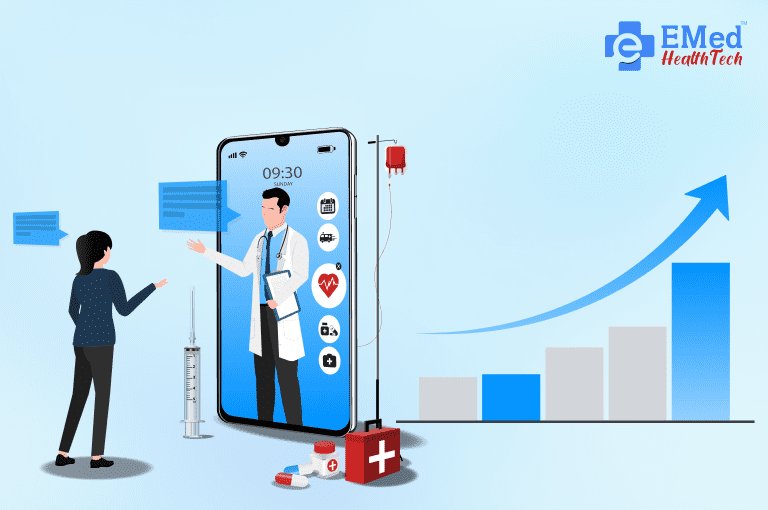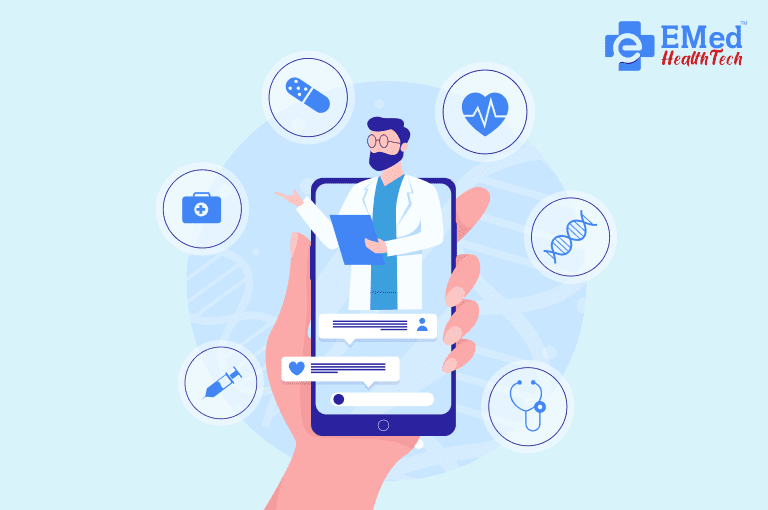The rise of telemedicine apps has caused a change in the way the healthcare industry is structured. Due in large part to the epidemic, the telemedicine sector has expanded dramatically on a global scale in recent years. The estimated value of the global market in 2018 was $50 billion, and by 2030, it is projected to grow to almost $460 billion. The dynamics of the healthcare sector have drastically shifted as a result of the COVID-19 epidemic. Now, the creation of software for telemedicine is the main priority for medical practitioners who want to provide their services to patients who are located remotely.
The ultimate goal of telemedicine is to give more freedom to physicians and patients. A few of the medical applications of this technology are tele-nursing, tele-psychotherapy, tele-video consultations, and remote monitoring. It could grow to be among the most crucial elements of the healthcare industry overall. It might have a huge positive impact on the business community overall if used properly. This is confirmed by the most recent study from Global Market Insights. According to the survey, the global telemedicine market is expected to reach $130.5 billion by 2025, up from $38.3 billion at now. In a poll investigating the broader use of these technologies, respondents said they have invested money in developing telemedicine applications.
Consequences for the Future of Telemedicine-Assisted Accessible Healthcare Provision
Most places in the globe have a shortage of qualified medical personnel. The ensuing distance barrier is one of the largest issues facing the healthcare sector. Many people have to travel great distances to receive top-notch medical care. Patients occasionally need to travel across international borders in order to receive care.
The abundance of telemedicine applications has made it possible to overcome the issue of physical distance in a number of ways. With Telehealth Software Development, patients can now have video medical consultations in a significantly shorter amount of time. The accessibility of healthcare services is being expanded by the availability of these applications.
Increasing the Medicines’ Effectiveness Worldwide
Advances in telemedicine have increased access to care as well as its quality for a greater number of people. Patients will thus have access to more individualized care. They don’t even need to leave their houses to schedule consultations with the top physicians and communicate with them via video chat.
Both patients and the medical professionals who treat them can benefit from the technology. There are now data management tools available that are more adapted to the needs of the medical industry. Furthermore, they have connections to a larger network of peers, which broadens their scope of medical knowledge.
Efficiency in the Provision of Healthcare Is Becoming More Evident
When compared to more traditional methods of providing medical care, the use of telehealth apps results in far lower overall costs. One of the main ways that the savings are made is that patients no longer need to physically visit the doctor’s office to receive treatment. The ease of a video consultation has many advantages for both the patient and the physician.
Quick Development in the Medical Field
Telemedicine App Development has played a significant role in the expansion of the healthcare industry in recent years. Compared to earlier times, there has been a significant improvement in the ease of conducting fresh investigations and medical research and development. Even medical students can now receive teaching and education at any time, anywhere, thanks to video conferencing.
Utilizing State-of-the-Art Technology to Develop Telehealth Applications
Regarding telemedicine technology, who knows what the future holds? In the coming years, telemedicine combined with artificial intelligence (AI), machine learning (ML), big data (DB), augmented reality (AR), virtual reality (VR), smart gadgets, etc., might offer it an advantage.
Some of the ways that technological advancements can be used to create telemedicine applications are as follows:
Chatbots powered by artificial intelligence
The topic of artificial intelligence chatbots in the context of telemedicine is currently the subject of extensive research. According to this research, it won’t be long until artificial intelligence (AI) manages first-patient interactions and refers patients to specialists as needed.
Artificial intelligence (AI) chatbots can respond to commonly asked questions and cover for human medical professionals when they are not accessible. The efficacy and efficiency of a physician’s workflow can be increased by artificial intelligence, which can automate tedious tasks.
Patient Monitoring via Telemedicine
As a subset of telemedicine, remote patient monitoring (RPM) is expanding quickly, with the potential to reduce readmissions by assisting physicians in following up with patients after they have been discharged from the hospital.
Vital signs can be recorded and sent to the physician by the patient’s linked devices, which can result in data-driven care that is ultimately better for the patient’s health.
The acronym “IoMT” stands for “Internet of Medical Things.”
Numerous patient data is saved by wearables and other linked devices, such as smartwatches and activity trackers.
IoMT and big data analytics together allow clinicians to more quickly identify patterns in patient data and modify treatment plans accordingly. Automated medication dispensers can save operating expenses and expedite the prescription process.
Blockchain
Although blockchain technology may be most famously associated with Bitcoin, its potential uses in the healthcare sector should not be overlooked.
If put into practice, blockchain technology might give the telemedicine platform a much-needed extra layer of security by offering a reliable record of all previous exchanges and transactions.
Who Should Get Employed to Develop a Mobile App for Telemedicine?
A critical stage in the Telehealth App Development process is selecting the development team you will collaborate with to produce your telemedicine application. The success of your project will ultimately depend directly on how well-developed the development team is that you collaborate with.
Which developers ought you to work with to make your telemedicine application? Is it better to hire a team of developers internally or seek out someone with experience in the field of healthcare development?
Even if you have in-house technical competence, hiring your own development team will still require a significant time and energy investment to get up and going. However, you will have more control over the finished product.
Additionally, there is a higher risk involved if thorough screening is done before the work method.
Last words
You may reduce the risks by working with experienced and skilled telemedicine app developers. They have experience with these kinds of projects and are familiar with the requirements needed to develop a telemedicine application.










